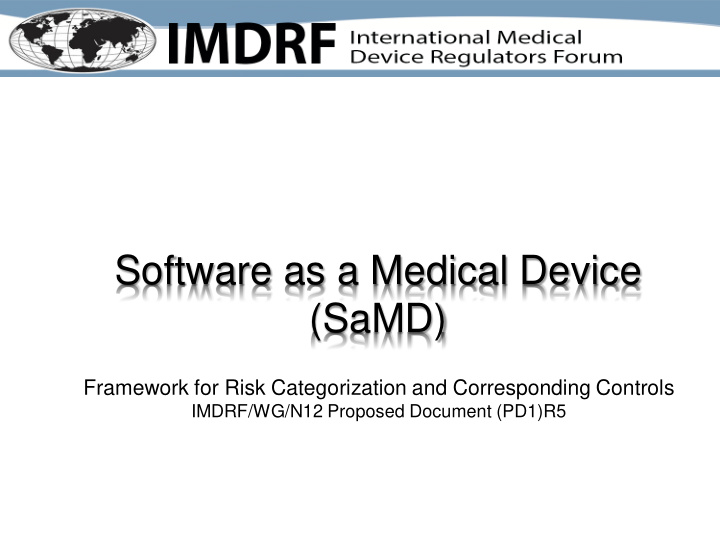



Software as a Medical Device (SaMD) Framework for Risk Categorization and Corresponding Controls IMDRF/WG/N12 Proposed Document (PD1)R5
Goals • International convergence and common understanding of Software as a Medical Device (SaMD): – Generic types of SaMD – Generic risks of SaMD that affect public health – Expectations of controls required to minimize generic risk • Establish a framework for regulators to incorporate converged controls into their regulatory paths or classifications. 3/13/2014 2
Proposed Timeline (combining phase II and III) 3
Approach Combined effort for N12/PD1 Phase III Phase I Phase II • What factors of SaMD • What are the affect public health risk? controls/expectations • SaMD Key definitions • What generic types of SaMD exists? Final: December 2013 • What are the generic risks for the types of IMDRF/N10/R2 SaMD? • Informal input from stakeholders SaMD Framework IMDRF/N12/PD1-R5 4
Framework Overview Common SaMD definition statement: • Medical purpose Corresponding controls • Context of use • Core functionality Level of independent oversight Type Risk Categorization Common process I expectation Conditions (1 -7) Type I , II, III, IV based on II are groupings by definition similarity in risk statement and III profile risk. IV Risk Categorization Corresponding controls 3/13/2014 5
SaMD Definition Statement A clear and strong statement enables common alignment in to appropriate SaMD type Includes the following key information: – The medical purpose of the SaMD: how it meets the definition of a medical device. – The Context of use of the SaMD: who is it for, how used, patient condition, target population, target disease, limitations of SaMD output. – A Description of the SaMD’s core functionality : what features/functions are essential to the intended medical purpose and context of use. 3/13/2014 6
SaMD Categorization and Types Types based on similarity of risk Categorization conditions based on: Type Impact examples • The information Level included in the I Very High Skin cancer diagnosis Definition Statement (purpose, context of II High analyzes rhythm to detect if a patient condition under intensive use) care has critically deteriorated • Risk profile: III Medium presents heart rate or other physiological parameters during – The importance of the routine checkups to track long information to the user: term progression of a condition – The impact of an invalid IV Low Used by patients to monitor their result physiological health on a daily basis 3/13/2014 7
Types of SaMD For a disease or condition when Type I Type II Type III Type IV the information is used… Very High High Medium Low Impact Impact Impact Impact In a Critical or as a primary or the only information imminent life In a Non- In a Serious (sole determinant) to treat or to threatening or Serious situation diagnose: life sustaining situation situation to drive clinical management which includes information that: To prevent To prevent or To prevent or • aids in treating, diagnosing or or mitigate mitigate in a mitigate in a screening; in a Critical Serious Non-Serious • aids in predicting or risk scoring; situation situation situation • aids in monitoring to inform clinical management which In a serious or includes information that: In a critical non-serious • prevents / mitigates; situation situation • supplements clinical management 3/13/2014 8
Key Highlights of Corresponding Controls • Specifically, the recommended controls for all types of SaMD are: – a quality management system (QMS), including – a system for post-market surveillance, – technical documentation. • All manufacturers are recommended to – Utilize international standards to perform risk management and quality management practices. – Be transparent in their labeling (including information used in the definition statement) – Follow general principles for Clinical Evaluation in GHTF SG5/N2R8:2007, and document as appropriate clinical safety, effectiveness, and performance data. 3/13/2014 9
Independent Oversight Corresponding to SaMD Types Summary of Controls Type I Type II Type III Type IV Risk Management – ISO 14971 X X X X Software development lifecycle – IEC 62304 class A X X requirements Software development lifecycle – IEC 62304 class B X requirements Software development lifecycle – IEC 62304 class C X requirements Labeling accompanying the device X X X X Clinical effectiveness X Clinical safety and performance X X Clear clinical efficacy statement accompanying the SaMD may “X” indicates where independent verification (3 rd party) or regulatory oversight is be based on bench test, simulated, or already available set of X X data. recommended. 3/13/2014 10
Thank You 3/13/2014 11
Recommend
More recommend